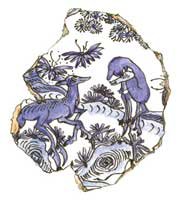Şabran (medieval city)
Coordinates: 41 ° 17 ′ 44 ″ N , 48 ° 52 ′ 52 ″ E
Şabran was a medieval city in Azerbaijan that existed from the 5th to the 18th centuries. It is located in what is now Sabran District .
history
The name of the city probably goes back to the time of the historical region of Shirvan and was originally, based on the name of Shirvan, before the metathesis Sharban or Sarban (Persian for caravan driver, camel driver).
Şabran originated between the fifth and seventh centuries and developed into an economic, cultural and administrative center. In the 10th and 11th centuries, the city formed an important political center of the state of Shirvanshah and was possibly also the capital of this state.
When the Mongols invaded in the middle of the 13th century, the city was conquered and partially destroyed. Reconstruction and revitalization of the city lasted from the beginning of the 14th century to the end of the 15th century. During the wars at the beginning of the 18th century, the city was conquered again and badly destroyed.
Historical mentions of the city
The Turk Evliya Çelebi wrote when he came to Şabran on a trip in 1647:
- ... It is the second largest city in Persia after Tabriz . It consists of 77 quarters and the mosque of Uzun Hasan . The walls of the mosque are thin and colorfully decorated, like the skin of a chameleon. Ornaments and sculptures are made of marble and astonish connoisseurs of architectural art.
AA Bakihanov was the first to suspect that the ruins not far from the village of Şahnəzərli, today Şabran Rayon (formerly Dəvəçi), are not the towns of Gjulistani-Irem, but the medieval Şabran.
social life
The population of Şabran was mostly Muslim , but there were also Jews and Christians .
architecture
In the years 1979–1999 archaeological excavations took place in the area of the city on five lots, an area of more than 4500 square meters was examined. Remains have been found up to a depth of 5 meters. The area of the excavations was surrounded by fortress walls, which, according to the scientists involved, served to protect the city. The walls are fortified with semicircular towers. Limestone, paving stones and bricks were used for the construction. The city was inhabited until the middle of the 13th century. In the 14th century, a small castle tower was built in the west of the destroyed fortress. It was square in shape and resembled a Abkhazian fortress. Mixed masonry was also used for its construction.
The excavations attest to the division of the city into individual quarters. The houses were built of bricks on a foundation. The city had a water supply network.
Craft
The economy of Şabran was based on handicrafts. During the excavations, among other things, a ten-piece set of fired dishes was found. A workshop dedicated exclusively to the production of these ceramics was discovered under the ruins of the city. Şabran's ceramic products have a variety of shapes and are richly decorated with ornaments.
Another successful industry was metal processing. Remains of smelters, coppersmiths, jewelers etc. were found. Ä., plus gold and silver rings with tools for their processing.
Different types of glass were also produced, some of which were exported to other countries. The greatest success in national trade was achieved with silk and woolen fabrics and carpets.
trade
The city had trade links with Syria , Egypt , China and the Maldives . The copper coins found testify to the developing domestic trade. During the excavations, an iron object was found that is reminiscent of a die.

